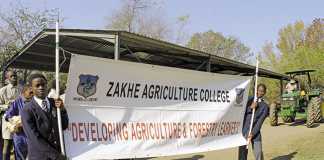Dr Gert Dry, vice president of Wildlife Ranching SA (WRSA), spoke to Roelof Bezuidenhout about the Seventh International Wildlife Symposium recently held in Kimberley and how the industry has modernised since the first symposium 23 years ago.
What was the symposium about?
Twenty-three international wildlife and hunting experts debated global best practices as well as negative aspects such as risks, dicey legislation, climate change, resource conservation, and poaching. The strengths and weaknesses of the SA wildlife industry received particular attention.
This year’s symposium attracted 500 visitors. The next Wildlife Ranching Symposium, scheduled for Mexico in two years, could focus on handling the challenges highlighted in Kimberley.
Wildlife ranching seems to encompass activities ranging from very intensive systems to very extensive ones. How would you define it?
Today, it’s not only about biodiversity conservation or only about economics. It also involves community-based natural resource management, consumptive and non-consumptive sustainable use of wildlife, human/wildlife interaction, wildlife management technology, health and veterinary implications, venison production and food security.
But basically, commercial wildlife ranching is the management of game in a sizeable game fenced system, with minimal human intervention in the form of the provision of water; the supplementation of food during drought; the strategic control of parasites and health care.
This means that animals should be assisted only where necessary so as not to lose natural parasite resistance and enzootic stability to diseases.
Aspects such as high fences, inbreeding and genetic manipulation and colour variations do come into play but regarding intensification, South African game ranches, at 2 050ha, are five to six times larger than in New Zealand and Europe. On the other hand, New Zealand exports 41 times more game meat than we do.
What excites you most about wildlife ranching?
Wildlife ranching fits into the modern world where there is a move towards more ecological lifestyles, but it is wrongly accused of being elitist and taking the food out of the mouths of the poor. In fact, it can improve livelihoods in developing countries, particularly in Africa.
The wildlife of no other continent comes close to the actual and potential value of that of South Africa and Namibia. If carefully managed, the commercial wildlife ranching industry will always be Southern Africa’s competitive advantage and unique selling point, especially as eco-tourism grows.
Some overseas delegates agreed that our model, in which game is owned privately, gives it an economic value leading to its conservation and a sustainable green economy.
What role can the industry play in rural development, poverty alleviation and food security?
While it is a land-use option that is still politically sensitive, there is no doubt it is an ecologically appropriate one, particularly in the context of climate change in already marginal regions where wildlife offers a much needed extra or alternative to livestock production.
One symposium presentation emphasised that higher temperatures would force people in poverty-stricken areas to adapt – or else they would need state aid to survive. As it is, less than 20% of the country is good agricultural land. And it is true that game is more adaptable to hot, dry climates than farm animals.
Already the commercial wildlife ranching industry has transformed 20 million hectare of marginal agricultural land into thriving land-use operations. WRSA members could assist the state with mentoring programmes for emerging black game farmers.
This would help them to operate profitably on dysfunctional provincial and local government “conservation” parks or conservancies that currently make no contribution to tourism or biodiversity, as well as on at least 12 million hectares of over-grazed communal land – if only the state would make these available.
Do you agree that commercial wildlife ranching should fall under the Department of Agriculture rather than the Department of Environmental Affairs?
The country already has about 10 000 game farmers – about 3 000 of them mixed game and livestock or even grain farmers. As almost all farms have some sort of wildlife on them, there’s an overlap between production issues and conservation.
Organised agriculture handles farmers’ interest regarding recognised agricultural commodities, labour, water and so on. WRSA looks after aspects of legislation regarding game management, Threatened or Protected Species (Tops) regulations, biodiversity, and translocation.
It seems logical that the agriculture department is better equipped to serve game ranchers and farmers. This is underlined by the fact that private conservation land by far exceeds state-owned conservation areas and that today about 2,5 million head of game are privately owned – four times more than on state-owned land.
There’s a feeling in the game industry that the Department of Environmental Affairs should focus on state-owned land rather than on private wildlife enterprises.
How profitable is game ranching?
The eco-tourism industry accounts for at least R1 billion in value added to the wildlife industry (private ranchers and parks adding value to game – via accomodation, viewing, crafts). Its indirect multiplier effect is of a roughly similar size. Total turnover in this segment is about R2 billion. Not surprisingly, the game ranching industry has been expanding at a rate of about 5% per annum in real terms during the past decade.
While the number of commercial farmers (all categories) has dropped to some 37 000, which are said to be getting older, game ranchers are getting younger – and making good money. Some game species now have astronomical value. For example, golden gnu have sold for R1,2 million a piece, buffalo for up to R18 million and black-backed impala for R550 000. Even yellow blesbok go for R13 000. Sadly, white rhino are quickly losing value due to poaching.
Buffalo farming gives return on capital of between 6% and 20%, depending on the type of operation. But a typical commercial game ranch generates around R220/ha of economic output, compared to an average R80/ha for conventional livestock farming. However, it is expensive to start up. On average, even the most successful game ranch requires at least R6 capital outlay for every R1 of revenue generated annually.
A small ranch requires an investment of R3,5 million; a large ranch would need at least R16,5 million. Another aspect is that game ranching is responsible for 100 000 jobs, including those in the game capture and translocation business. During the 2010 season, nearly 170 000 head of game were translocated by 44 game capture companies.
What’s the economic potential for game meat?
During the five hunting months of the year, game meat provides 10% of red meat consumed in South Africa. The potential international market size for game meat – an organic and ‘natural’ product – is more than 100 000t/year, while current supply stands at a mere 35 000t.
While New Zealand exports 40 000t or 700 000 head valued at R2,5 billion annually, we lag far behind, exporting only between 600t and 2 000t, worth between R60 million to R200 million annually.
What are the main challenges facing game ranching?
The rhino poaching scourge is a warning that other game species could be under threat and that they are not sufficiently valued by our authorities, who seem to have no solution to the problem of illegal trade. Several experts feel that a moratorium on hunting rhino would place the species at even greater risk as it would encourage uncontrolled hunting and make it uneconomical to ranch with them.
We also have to contend with animal rights activists who use pseudo-research results and emotional rhetoric to undermine the industry. Before game ranching became a private form of business, only 19 bontebok, 2 000 blesbok and 30 white rhino were left in South Africa. We now have more game than 150 years ago. This shows what private ownership and scientific ranching can achieve.
Email Dr Gert Dry at [email protected].













